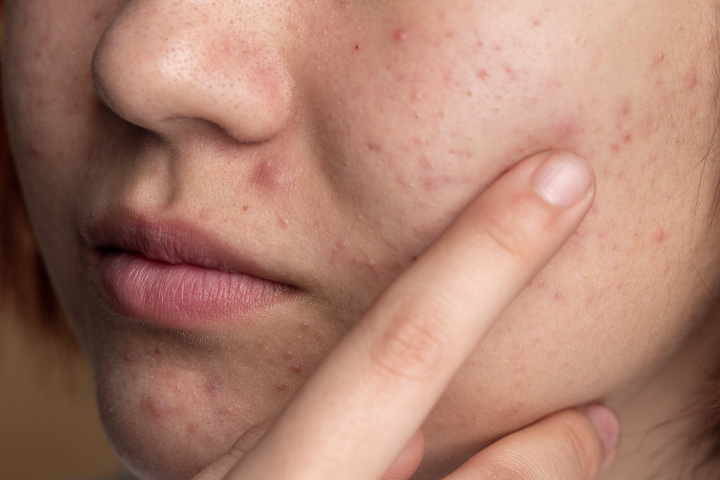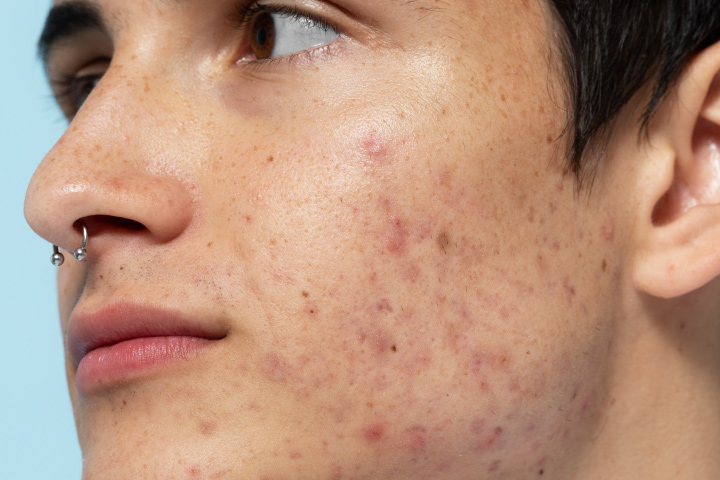Acne

Are you tired of dealing with stubborn acne that just won't go away?
Acne is a common skin condition where oil and dead skin cells clog the skin’s follicles and pores, causing the development of whiteheads, blackheads, and pimples which typically occur on the face, neck, chest, back, and shoulders. The pimples appear as lumps on faces of various sizes, which are pus-filled and occasionally hurt.
Acne can also be caused by various factors, including hormonal changes, genetics, stress, and certain medications. It can be frustrating and embarrassing, and can often leave behind scars and blemishes.
Despite acne being a common skin condition, it doesn’t mean you have to live with it. Our acne-fighting products and treatments are specially formulated to help you achieve clearer, healthier-looking skin. Say goodbye to those pesky pimples and hello to a more confident you.


Who gets Acne?
The answer might surprise you: just about everyone! Acne is a skin condition that can affect people of all ages and genders. While it’s more prevalent in adolescents and young adults due to hormonal changes, adults can also experience acne. Family history can play a role in developing acne. If your parents or siblings struggled with breakouts, there’s a higher chance you might too.
As per some research, up to 80% of people between the ages of 11 and 30 are expected to experience acne at some point in their lifetimes. However, people of all ages, including infants and those in their 50s and beyond, are susceptible to contracting it.
Types of Acne
Acne comes in a variety of forms, including:
- Comedonal Acne: Whiteheads and blackheads are defining features of comedonal acne.
- Inflammatory acne: This type of acne is defined by the development of red, swollen bumps called papules, pustules, and nodules.
- Cystic acne: It is distinguished by the existence of sizable, uncomfortable, and deep cysts.
- Hormonal acne: It is brought on by the body’s hormonal changes, such as those that occur during adolescence or menstruation.
The fact that every person will experience acne uniquely, with differing degrees of severity and variety, is important to note.
What Causes or Triggers Acne?
There are several variables that cause acne, including:
- Excessive oil production: Acne can result from excessive oil production from the skin’s sebaceous glands.
- Bacteria: Propionibacterium acnes bacteria can develop and spread in clogged pores, resulting in inflammation and acne.
- Hormonal changes: Skin glands may produce more oil in response to hormonal changes, especially during puberty. Hormonal changes particularly those that occur during adolescence, menstruation, pregnancy, and menopause might trigger acne.
- Diet: Having a diet rich in sugars and refined carbohydrates, dairy products may increase your risk of developing acne.
- Genetics: There are data that suggests genetics may be involved in the emergence of acne.
Furthermore, a number of pharmaceuticals, including some lithium, some anti-seizure medications, and steroids, can also result in acne.
How can Acne be cured?
Backed by science and formulated with proven ingredients, our acne solutions are designed to effectively combat acne at its source and provide you with long-lasting results. Whether you have oily, dry, or sensitive skin, our acne treatments are tailored to address your unique skin needs and concerns.
Also, there are a number of therapies that can lessen the severity of the symptoms. Options for treatment include:
- Topical drugs – Creams, gels, and ointments containing retinoid, salicylic acid, or benzoyl peroxide can help to clear clogged pores and lessen the irritation.
- Oral medications – In more severe instances of acne, antibiotics or birth control pills may be given to help reduce inflammation and regulate hormone levels.
- Light therapy – Blue light therapy can help to decrease inflammation and kill the bacteria that cause acne.
- Chemical peels: By applying a chemical solution to the face, dead skin cells are exfoliated and removed, clogged pores are cleaned, and sebum production is decreased.
- Extraction – A dermatologist may physically remove blackheads and whiteheads from the skin using a specialized tool.
What may be the symptoms of Acne?
Numerous signs can accompany acne, but the following are the most typical ones:
Depending on the individual, acne can range in severity from a few minor pimples to serious acne that may leave scars. Despite all of this, it is treatable with the right care.
Preventions for Acne
There are several steps that can be taken to lower the risk of developing acne, even though there is no perfect method to prevent it. These include:
- Keep your face clean – Wash your face twice a day with a gentle cleanser to remove dirt, oil, and makeup.
- Avoid touching your face – Your hands come into contact with millions of germs every day, so try to avoid touching your face as much as possible.
- Use non-comedogenic products – Look for skincare and cosmetic products that are labelled as non-comedogenic, meaning they are less likely to clog your pores.
- Eat a healthy diet – While there is no direct link between diet and acne, eating a healthy diet can help to promote overall skin health.
- Manage stress – Stress can trigger acne outbreaks, so finding ways to manage stress, such as through meditation or exercise, can be helpful.

